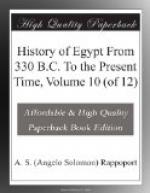Among the men of letters who at this time taught in the Alexandrian schools was Aristophanes, the grammarian, who afterwards held the office of head of the museum. At one of the public sittings at which the king was to hear the poems and other writings of the pupils read, and, by the help of seven men of letters who sat with him as judges, was to give away honours and rewards to the best authors, one of the chairs was empty, one of the judges happened not to be there. The king asked who should be called up to fill his place; and, after thinking over the matter, the six judges fixed upon Aristophanes, who had made himself known to them by being seen daily studying in the public library. When the reading was over, the king, the public, and the six other judges were agreed upon which was the best piece of writing; but Aristophanes was bold enough to think otherwise, and he was able, by means of his great reading, to find the book in the library from which the pupil had copied the greater part of his work. The king was much struck with this proof of his learning, and soon afterwards made him keeper of the library which he had already so well used. Aristophanes followed Zenodotus in his critical efforts to mend the text of Homer’s poems. He also invented the several marks by which grammarians now distinguish the length and tone of a syllable and the breathing of a vowel, that is, the marks for long and short, and the accents and aspirate. The last two, after his time, were always placed over Greek words, and are still used in printed books.
Eratosthenes of Cyrene, the inventor of astronomical geography, was at this time the head of the mathematical school. He has the credit for being the first to calculate the circumference of the earth by means of his Theory of Shadows. As a poet he wrote a description of the constellations. He also wrote a history of Egypt, to correct the errors of Manetho. What most strikes us with wonder and regret is, that of these two writers, Manetho, an Egyptian priest who wrote in Greek, Eratosthenes, a Greek who understood something of Egyptian, neither of them took the trouble to lay open to their readers the peculiarities of the hieroglyphics. Through all these reigns, the titles and praises of the Ptolemies were carved upon the temples in the sacred characters. These two histories were translated from the same inscriptions.




